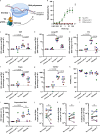Efficient mRNA delivery to resting T cells to reverse HIV latency
- PMID: 40442114
- PMCID: PMC12122926
- DOI: 10.1038/s41467-025-60001-2
Efficient mRNA delivery to resting T cells to reverse HIV latency
Abstract
A major hurdle to curing HIV is the persistence of integrated proviruses in resting CD4+ T cells that remain in a transcriptionally silent, latent state. One strategy to eradicate latent HIV is to activate viral transcription, followed by elimination of infected cells through virus-mediated cytotoxicity or immune-mediated clearance. We hypothesised that mRNA-lipid nanoparticle (LNP) technology would provide an opportunity to deliver mRNA encoding proteins able to reverse HIV latency in resting CD4+ T cells. Here we develop an LNP formulation (LNP X) with unprecedented potency to deliver mRNA to hard-to-transfect resting CD4+ T cells in the absence of cellular toxicity or activation. Encapsulating an mRNA encoding the HIV Tat protein, an activator of HIV transcription, LNP X enhances HIV transcription in ex vivo CD4+ T cells from people living with HIV. LNP X further enables the delivery of clustered regularly interspaced short palindromic repeats (CRISPR) activation machinery to modulate both viral and host gene transcription. These findings offer potential for the development of a range of nucleic acid-based T cell therapeutics.
© 2025. The Author(s).
Conflict of interest statement
Competing interests: S.R.L. has received honoraria unrelated to the content of this manuscript for participation in advisory boards for Gilead, Viiv Healthcare, Merck, Abbvie, Esfam, Immunocore and First Health. She has received funding from Gilead and Merck for investigator-initiated research projects unrelated to the content of this manuscript. DLF and FC are scientific founders of and hold equity in Messenger Bio. Messenger Bio was paid to synthesise mRNA for 60% of the work presented in the manuscript. P.M.C. was supported by a donation from the J and M Wright Foundation. The donation supported salary to complete some of this work. B.M.F., M.A.M., R.A.S. were supported by an Australian Government Research Training Programme Scholarship. M.A.M. was further supported by an NHMRC Postgraduate Scholarship, Rowden White Scholarship and Elizabeth Mary Sweet Scholarship. K.T. was supported by a Melbourne Research Scholarship. P.M.C., S.K., B.M.F., M.A.M., M.F., M.R., J.S. and S.R.L. are named investigators on a patent related to this work (PCT/AU2024/050506). No other authors declare any competing interests.
Figures





Similar articles
-
CRISPR-Cas9 Mediated Exonic Disruption for HIV-1 Elimination.EBioMedicine. 2021 Nov;73:103678. doi: 10.1016/j.ebiom.2021.103678. Epub 2021 Nov 10. EBioMedicine. 2021. PMID: 34774454 Free PMC article.
-
HIV Tat as a latency reversing agent: turning the tables on viral persistence.Front Immunol. 2025 Apr 11;16:1571151. doi: 10.3389/fimmu.2025.1571151. eCollection 2025. Front Immunol. 2025. PMID: 40292298 Free PMC article. Review.
-
Naf1 Regulates HIV-1 Latency by Suppressing Viral Promoter-Driven Gene Expression in Primary CD4+ T Cells.J Virol. 2016 Dec 16;91(1):e01830-16. doi: 10.1128/JVI.01830-16. Print 2017 Jan 1. J Virol. 2016. PMID: 27795436 Free PMC article.
-
Analysis of human immunodeficiency virus type 1 gene expression in latently infected resting CD4+ T lymphocytes in vivo.J Virol. 2003 Jul;77(13):7383-92. doi: 10.1128/jvi.77.13.7383-7392.2003. J Virol. 2003. PMID: 12805437 Free PMC article.
-
The multifactorial nature of HIV-1 latency.Trends Mol Med. 2004 Nov;10(11):525-31. doi: 10.1016/j.molmed.2004.09.006. Trends Mol Med. 2004. PMID: 15519278 Review.
Cited by
-
CRISPR/Cas9 for achieving postintervention HIV control.Curr Opin HIV AIDS. 2025 Sep 1;20(5):432-440. doi: 10.1097/COH.0000000000000963. Epub 2025 Jul 18. Curr Opin HIV AIDS. 2025. PMID: 40682401 Free PMC article. Review.
References
-
- Luigetti, M. & Servidei, S. Patisiran in hereditary transthyretin-mediated amyloidosis. Lancet Neurol.20, 21–23 (2021). - PubMed
-
- Gillmore, J. D. et al. CRISPR-Cas9 in vivo gene editing for transthyretin amyloidosis. N. Engl. J. Med.385, 493–502 (2021). - PubMed
-
- Deeks, S. G. et al. Research priorities for an HIV cure: International AIDS Society Global Scientific Strategy 2021. Nat. Med.27, 2085–2098 (2021). - PubMed
-
- Finzi, D. et al. Identification of a reservoir for HIV-1 in patients on highly active antiretroviral therapy. Science278, 1295–1300 (1997). - PubMed
MeSH terms
Substances
Grants and funding
- 1149990/Department of Health | National Health and Medical Research Council (NHMRC)
- 1135851/Department of Health | National Health and Medical Research Council (NHMRC)
- UM1 AI164560/AI/NIAID NIH HHS/United States
- 110406-73-RGRL/amfAR, The Foundation for AIDS Research (amfAR)
- 1UM1AI164560-01/U.S. Department of Health & Human Services | NIH | Office of Extramural Research, National Institutes of Health (OER)
LinkOut - more resources
Full Text Sources
Medical
Research Materials

